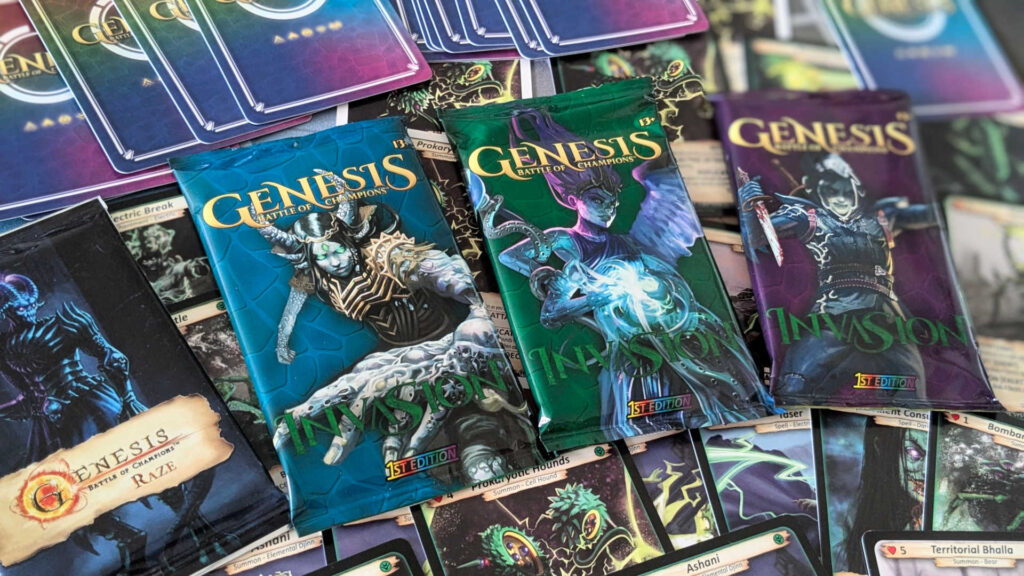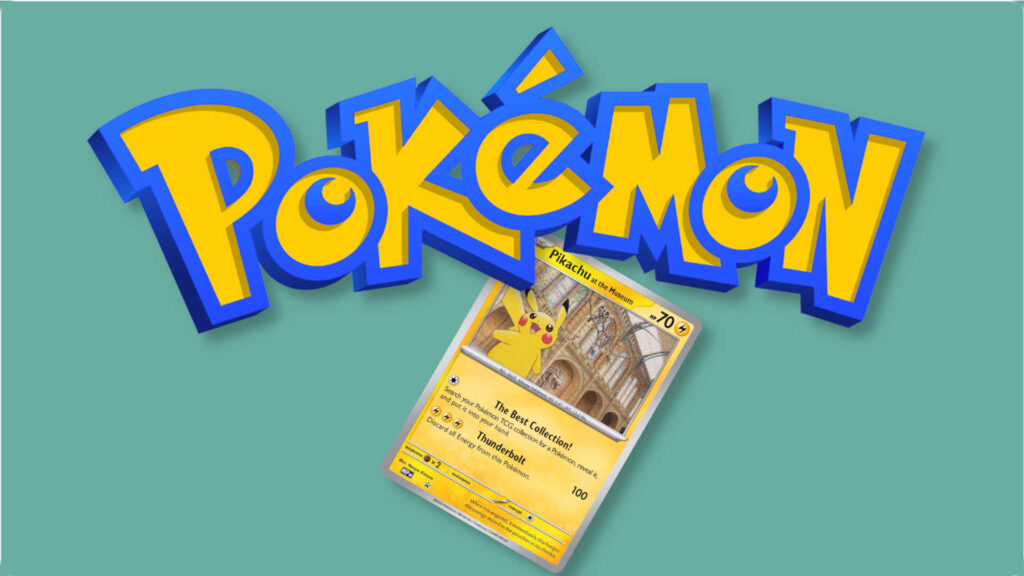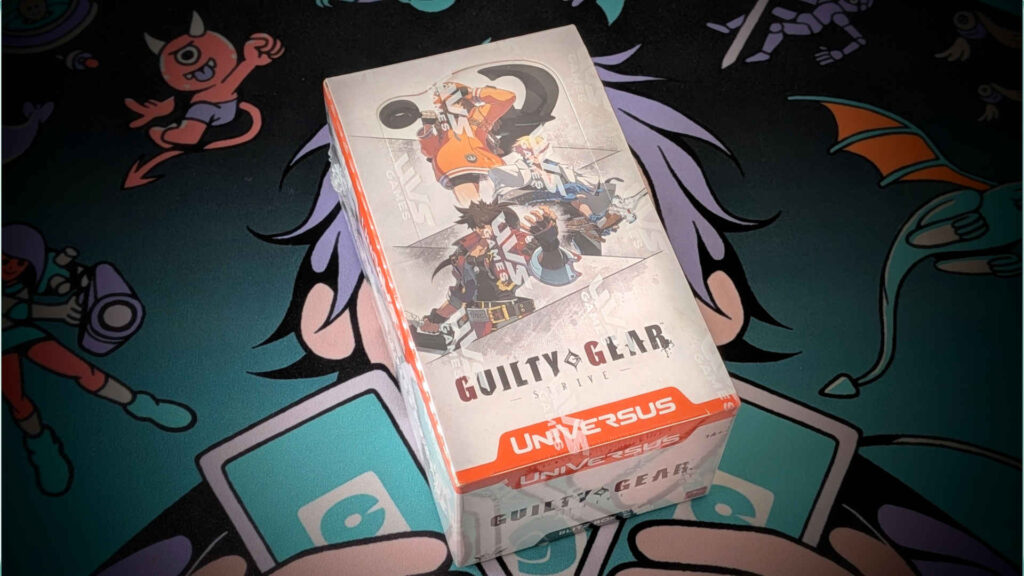The trading card game (or TCG) scene is currently thriving in a way that hasn’t been seen since the initial 90s boom, which was kicked off by the pioneering, genre-creating Magic: The Gathering’s arrival in 1993. Over the last few decades, the TCG market had been dominated by “the big three”: the aforementioned Magic: The Gathering, Pokémon and Yu-Gi-Oh!. However, titles such as Disney Lorcana and Star Wars Unlimited, though having big name licenses attached, have proven that the community can sustain many more games, as have TCGs such as Flesh and Blood, Altered and many more, without the benefit of familiar IPs. A further example of a TCG which seems to have found a willing and eager community is Genesis: Battle of Champions. It’s another game which doesn’t rely on a big name license to sell itself; instead, it prides itself on unique mechanics that truly sets it apart from other games. Is it worth playing? Let’s find out!
Table of Contents
ToggleWhat is Genesis: Battle of Champions?
A TCG which sees players engaging in grid-based combat in order to defeat their opponent’s champions, Genesis: Battle of Champions sets itself apart from other trading card games with some unusual and compelling mechanics. There’s the aforementioned combat, which takes place in a rectangular arena composed of 5×6 spaces, along with some welcome, rare flexibility in terms of the game’s deckbuilding aspects.
Getting Started With Genesis: Battle of Champions
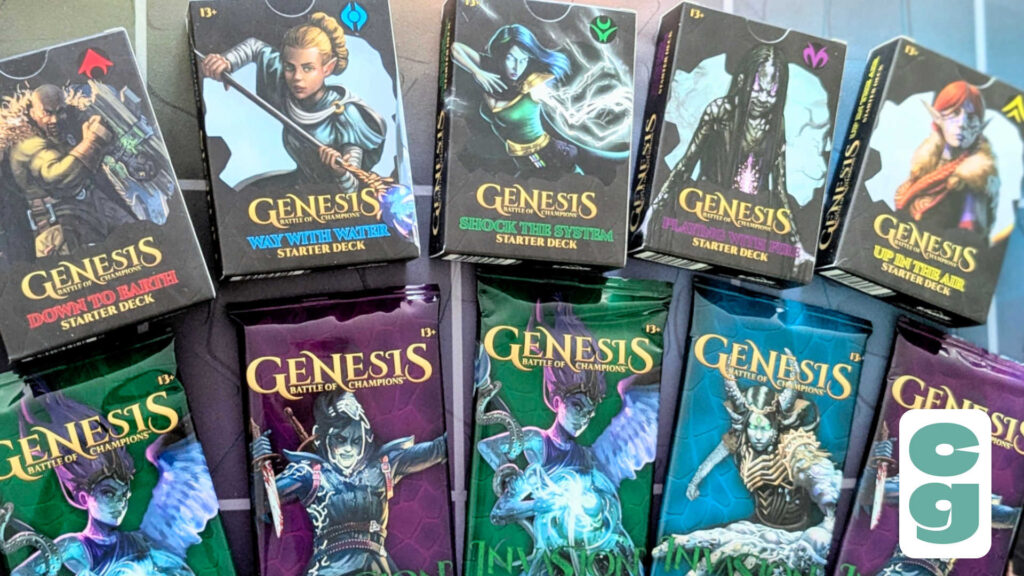
Each player has their own deck (also called a timeline in game terminology; more on this later), along with a champion. They’ll be able to use a pre-constructed starter deck (you can see five of these in the above image), or build their decks from cards collected from booster packs.
Each player’s deck/timeline is shuffled and placed face down near them, outside the arena; each champion is placed in the middle column, on the edge of the arena closest to its player. Any “subconscious” cards are placed outside the arena (again, close to the player they belong to).
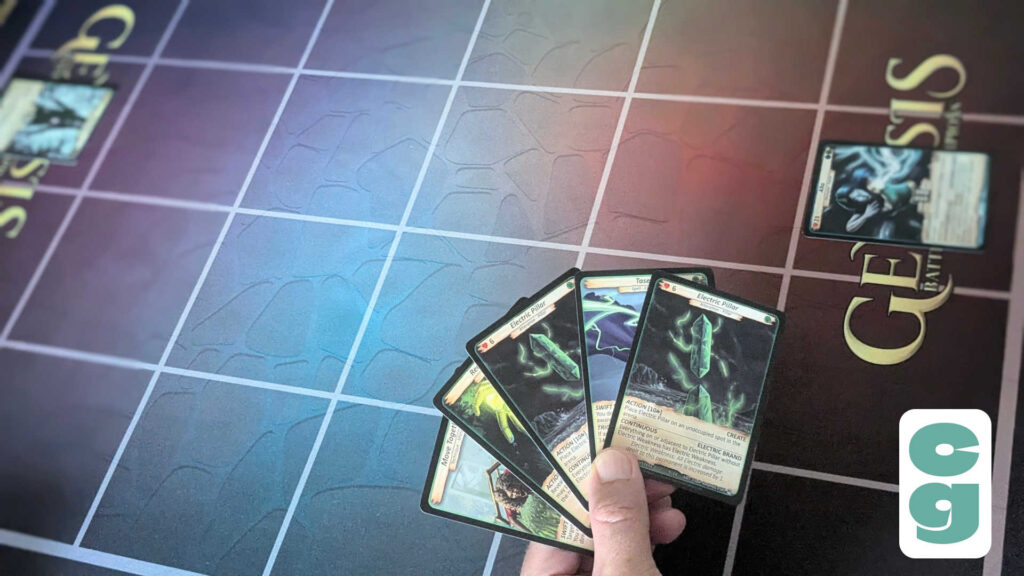
Players must also begin the game with a clear method of tracking their aura and HP levels. The start player is randomly determined by a method agreed upon by both players, and each player draws 5 cards from their timeline to begin.
How to Play Genesis: Battle of Champions
The turn phases of Genesis: Battle of Champions aren’t too dissimilar from most other TCGs, so if you’re familiar with just about any other trading card game, you should at least be fine to get your head around the structure here. There are differences, of course, owing to the unique mechanics of Genesis: Battle of Champions, but once you have the basics in mind, you’ll see where the similarities and differences to other TCGs are fairly swiftly.
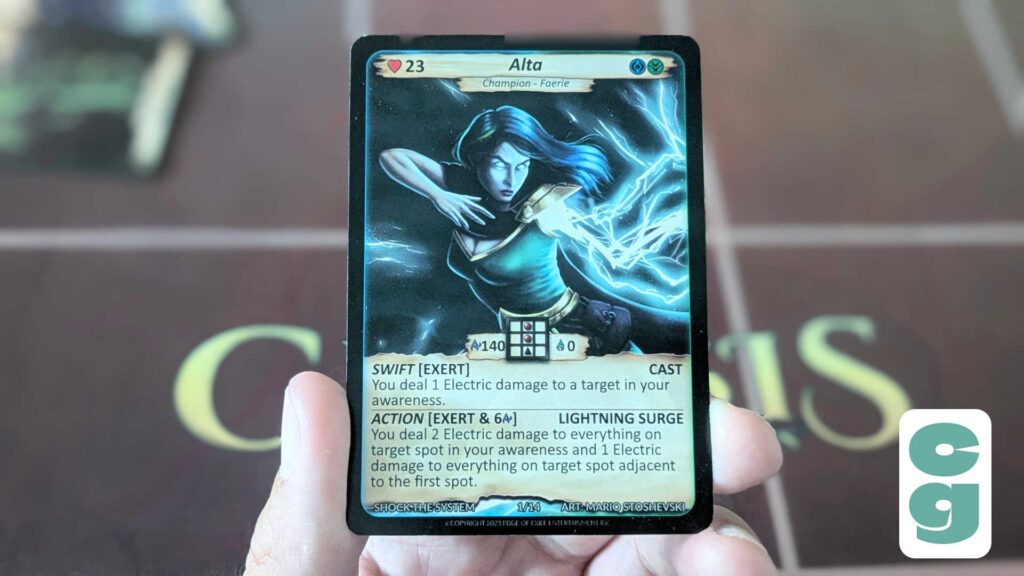
Of course, the main, huge difference with Genesis: Battle of Champions is its grid-based combat, and rounds are played in turns, with the first player activating their chosen card (champions, one example shown above, and summon cards, all known as “Combatants”), then passing to the next player.
At the start of a round, each player removes all Exert markers from their cards and draw a card. This is really important: because card positioning is important and part of every turn, you can’t simply turn a card sideways to exert it, as you would in many other TCGs; that’s why Exert markers are used instead.
The start phase sees the active player choosing a Combatant, moving them (one space or two, or rotating their card as a point of movement, moving again if they wish) and then playing abilities, and other cards (such as those shown below) during the main phase.
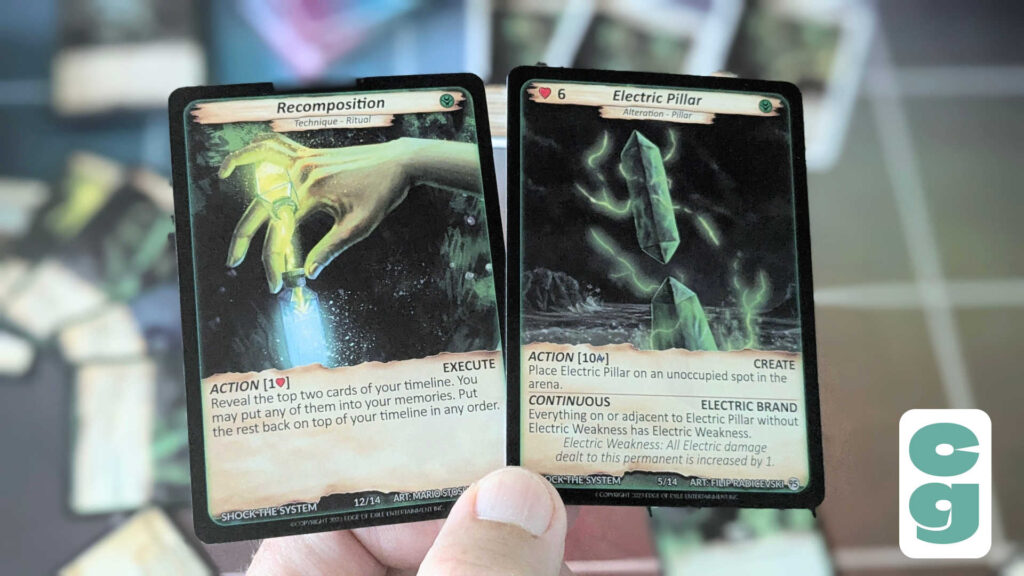
Action abilities can be played if the active Combatant only moved one space, or rotated just once; moving or rotating twice will see the Combatant skipping their main phase and moving straight to the end phase. Playing actions from your hand or using abilities on the active Combatant is what happens during the main phase. There are a variety of ways to pay for actions to be played, including using your aura (each champion starts with a certain amount of aura at the outset of the game), using HP or even discarding cards from the top of the deck.
The end phase is the point where players have a final chance to play swift abilities before the active Combatant itself is exerted. Play then moves to the next player to activate a Combatant, and this continues until each player’s champion and summon cards are exerted. Then the round ends and a new one begins.
How Does Combat Work in Genesis: Battle of Champions?
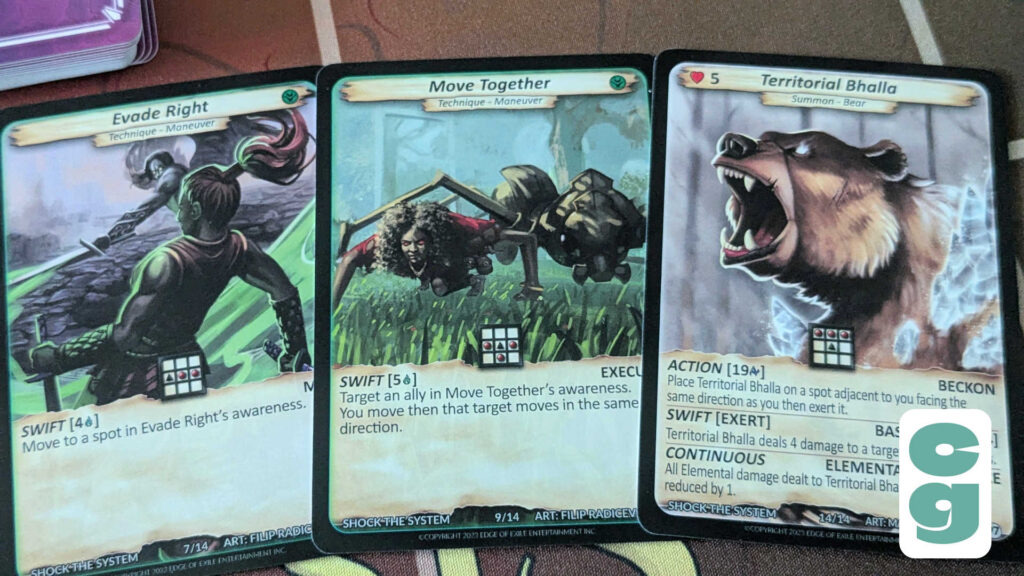
It’s a bit of a trick question, because there is no combat in Genesis: Battle of Champions; certainly not in the traditional sense of cards squaring up and trading damage in any case. Unless the card being targeted, or other cards, with their own awareness grid, can respond. Each champion, summon and many other cards of varying types in Genesis: Battle of Champions show a grid, known as awareness, at the bottom of their card’s illustration. You can see this clearly in the images above and below.
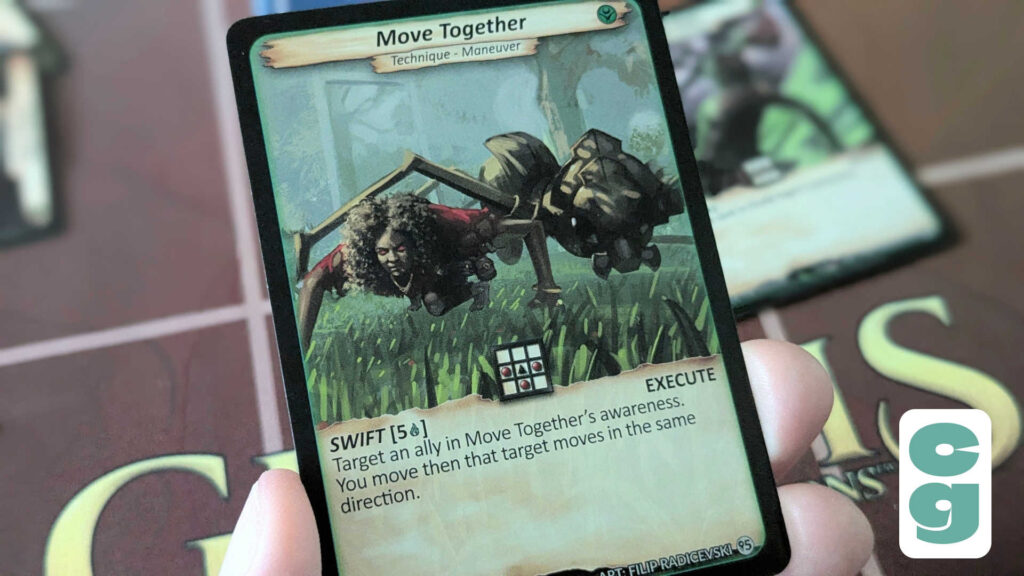
This shows where the card’s attack or effect can be carried out on the arena, with the triangle being the card or unit it’s being used by, and the circles showing the area of effect or squares which can be attacked. This is also why positioning and movement plays such a crucial part of the game’s strategy.
Players use their awareness to attack specific spaces in the arena, and deal the damage specified in the attack ability that’s being used; there’s a wide variety of attack types, and this will be specified on a card’s text. As will the area of effect of the attack, and the type of damage it deals too.
How to Win a Game of Genesis: Battle of Champions
If you defeat all of the opposing player’s champions (by reducing their HP to zero), or they run out of cards in their deck, you win.
Is Genesis: Battle of Champions Fun to Play?
There’s so many unique and interesting elements to Genesis: Battle of Champions that it really is a very engaging and unusual game, for a TCG at least. The grid-based movement and attacking adds a real board game-esque element to the experience, and a tactical, spatial feel that you just don’t usually get with a TCG.
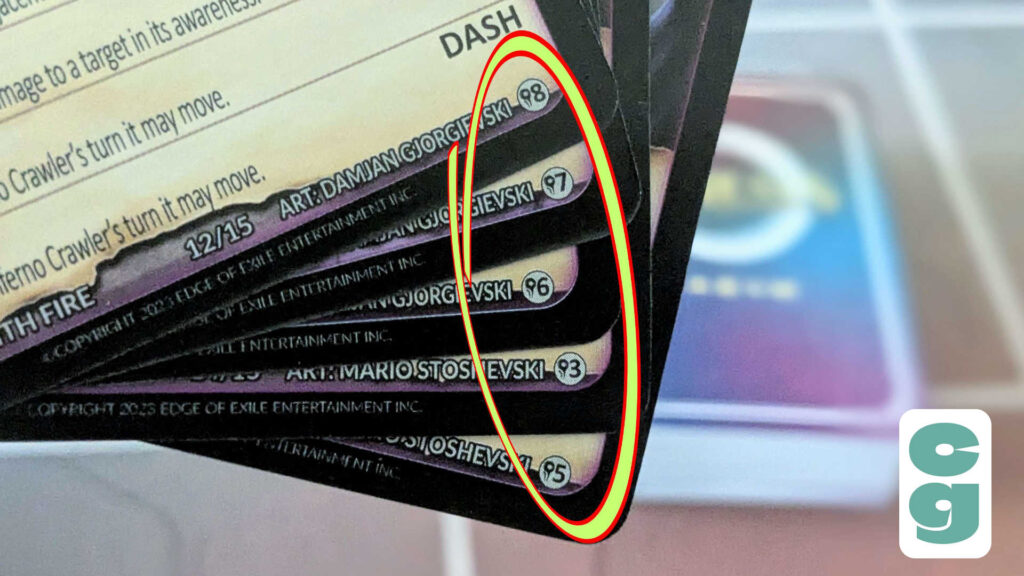
Speaking of unique elements in Genesis: Battle of Champions, even deckbuilding has a flavor which is unlike anything we’ve seen in TCGs before. Usually, there’s a limit on the number of cards with the same title that you can include in a deck, in any given game, but the deckbuilding rules of Genesis: Battle of Champions actually doesn’t have that, and this allows for a huge amount of flexibility in your build. There are a few guidelines, as you’d expect. The deck must have 50 cards, no cards can have any affiliated colors that don’t appear on the Champion, and there must not be a total of more than 250 Chi (with examples of the Chi values on cards shown circled above) on all cards. Those rules aside, pretty much anything goes.
There are a few issues, however. I’m really not a fan of games using alternative names for standardized concepts, and unfortunately Genesis: Battle of Champions really overdoes this, in a way that makes it much more difficult to learn and absorb, and necessitates a glossary of terms on the player aid card (shown below) that’s entirely avoidable. Using “timeline” instead of deck, “thoughts” instead of hand and “forethoughts” instead of sideboard, among other terms, just makes things unnecessarily complicated.
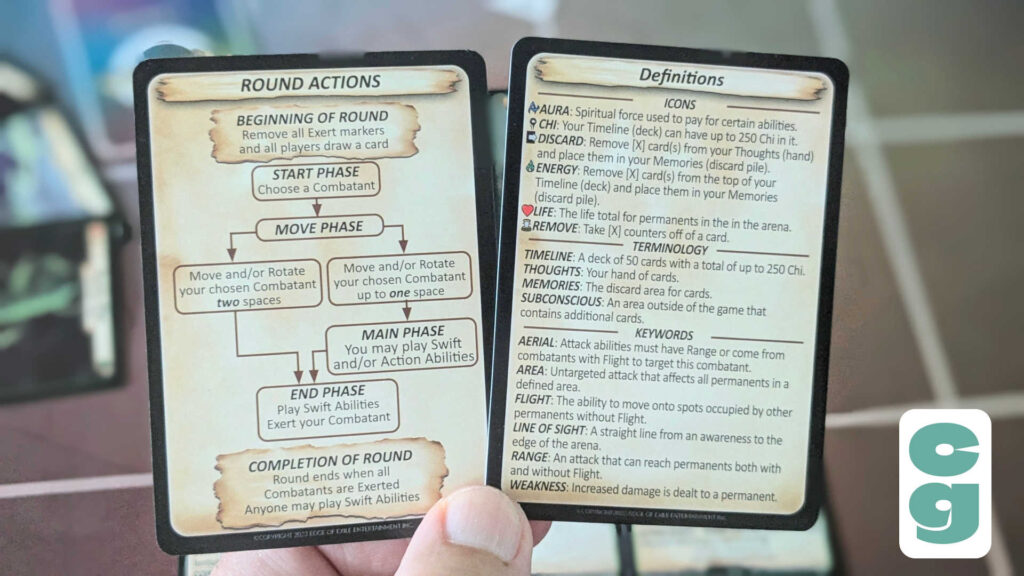
The awareness grids can sometimes be a little difficult for the opponent to see at a glance too, and it’s obviously crucial to know exactly where you’re vulnerable to attacks from your foes at any given time. Additionally, there’s a need for quite a lot of tracking of in-game values and statuses, and this requires the use of an app as well as counters or tokens you’ll need to provide yourself.
The stack, which will be a familiar concept to many old school TCG players, also requires a bit more depth of understanding than many modern TCGs, which feel much more streamlined and accessible in terms of their overall design. That said, this element of the game does mean that there’s plenty of abilities present which can trigger at various times, keeping the game feeling like a tug of war between two determined opponents.
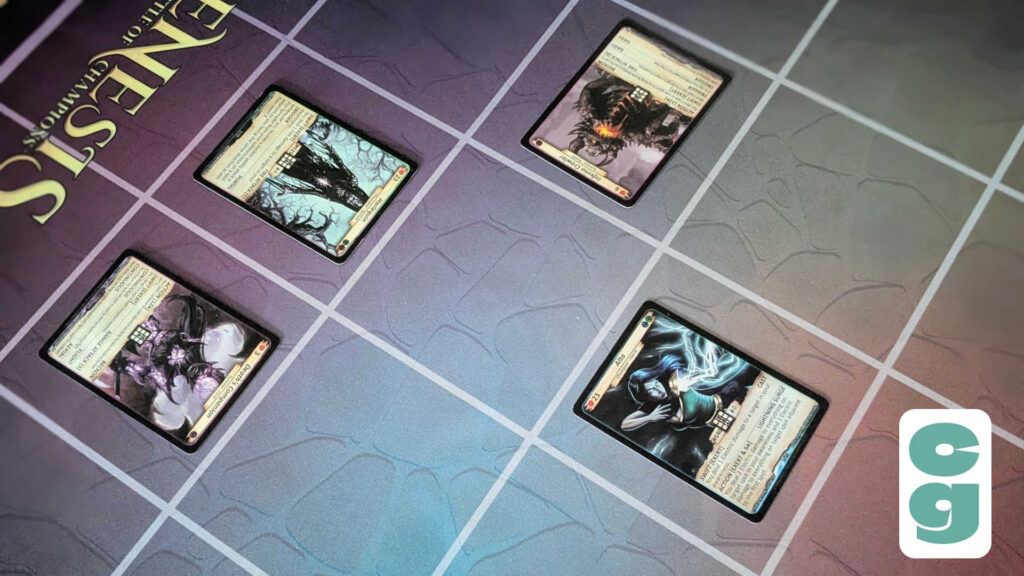
Even with those (admittedly pretty minor) issues in mind, Genesis: Battle of Champions is very well put together, and really does feel unlike any other TCG currently available. It’s currently in the midst of a sort of soft reboot, with a refining of the card designs and new expansions on the way. It’s a game built for play, which may seem a bit of an odd declaration to make, but so many TCGs these days have collecting and card value in mind that they lose sight of actual gameplay. Though you can find gorgeous, foil-treated cards in booster packs, as you’d expect of any TCG, Genesis: Battle of Champions feels like a truly “gameplay first” experience, and is all the stronger for it.
The Card Gamer Verdict
For an independently produced game, Genesis: Battle of Champions has some truly excellent card art and impressive production values, but it does have a lack of tokens and components; a helpful app does ensure that both players can keep on top of their aura and champion’s HP though. The tried and true method of pen and paper can be used just as effectively too!
Unique mechanics and compelling, grid-based gameplay make Genesis: Battle of Champions a pretty peerless experience for a TCG, and the same goes for its flexible deckbuilding mechanics that allow for a huge amount of player creativity.
I’m looking forward to diving deeper into Genesis: Battle of Champions, and despite the game having been around for some time already, there’s arguably never been a better time to jump on board and discover its unique, thoughtfully designed and very compelling gameplay.
You can find out more about Genesis: Battle of Champions on the game’s official website.
Still here? Why not check out our reviews of other independent TCGs, such as Achroma or Ulandi Wars?


